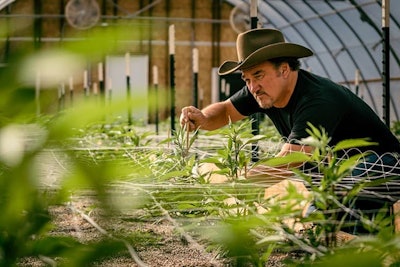
Last night, actor and comedian Jim Belushi made his way back to the silver screen—this time by documenting the trials and tribulations of owning and operating his state-legal cannabis farm in Oregon in the new reality series “Growing Belushi” on Discovery Channel.
The series, airing on Wednesdays at 10 p.m. ET, will provide a snapshot into the daily life of Belushi and his “ragtag team of farmers” as they “follow their passion and find success in something they believe in,” according to a Discovery Channel press release. “Joined by his cousin Chris and with appearances from Dan Aykroyd, Judy Belushi and a cast of misfits (including Jim’s own family), as well as a musical appearance by The Blues Brothers, ‘Growing Belushi’ will take Discovery’s audiences inside Jim’s world and show the incredible effort it takes to build a legal cannabis operation.”
In the first seven minutes of the series premiere, viewers got a peek into the backstory of what inspired Belushi’s journey into cannabis, including the passing of his late brother John Belushi, as well as his humble beginnings of learning a complicated industry. “Jim knew nothing,” Megan, a land use consultant, reflected while laughing. Viewers see first-hand via sprawling drone footage over the farm that he’s come a long way since then.
Alternating between comedic relief (like Belushi’s daily skinny dip into his pond) and the history of the cultivars that make up Belushi’s genetic line-up (i.e. Captain Jack, whose namesake Jack, famously known as the ‘weed dealer’ on Saturday Night Live in the 70s, now works with the farm)—"Growing Belushi" has all the elements classic to reality TV: quick edits, interview soundbites with music and sound effects to match the moment, and, of course, a little bit of drama. The first issue presented is the report of two cultivation employees, Ben and Alex, who plan to skip out of work at 4 p.m.—knowing full well that the Captain Jack plants need sprayed at 5.
“We are always looking for a show that takes you by surprise and this one did - it’s fun and funny and has a lot of heart. I think people will see Jim Belushi in a whole new way after watching,” said Nancy Daniels, Chief Brand Officer, Discovery & Factual, according to the press release.
Cannabis Business Times profiled Jim Belushi’s operation in its March 2020 cover story. In it, he said, “We all try to throw a pebble into the pond to make a ripple,” reflecting on the impact individuals can have in their various circles. “When you have celebrity status, you bring focus to the pond, and you have the ability to throw a boulder into the pond and make a big wave. That’s a responsibility, and you’ve got to step up to it.” Read the full story here.

























